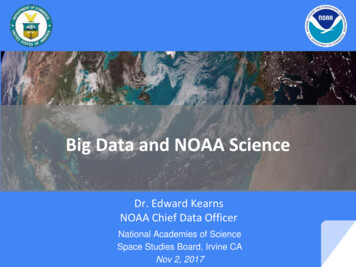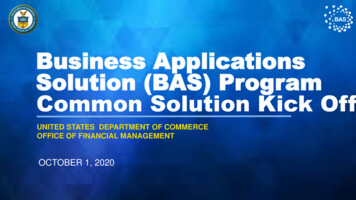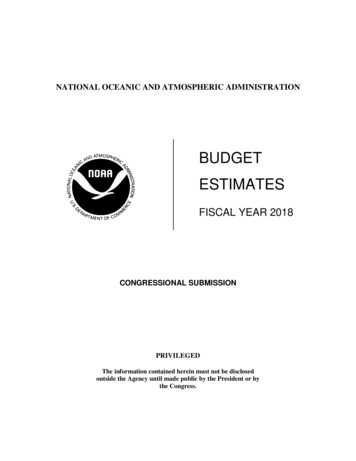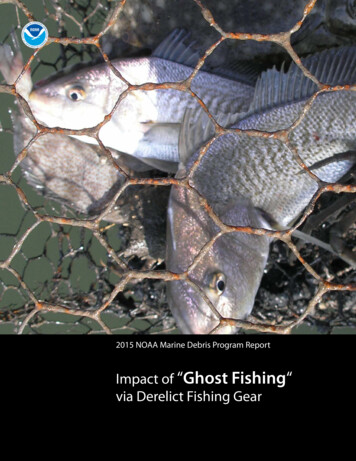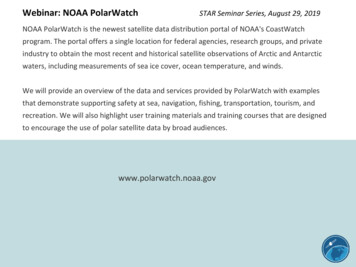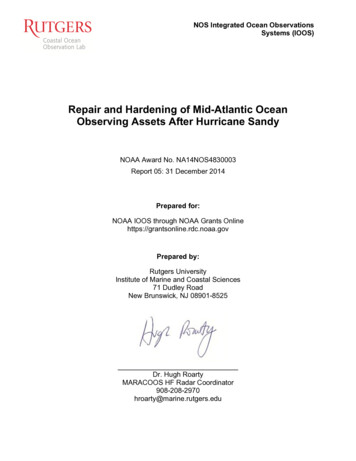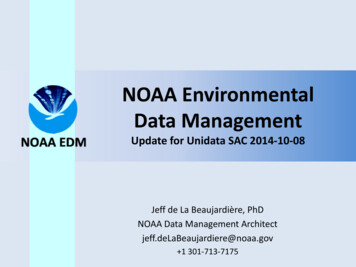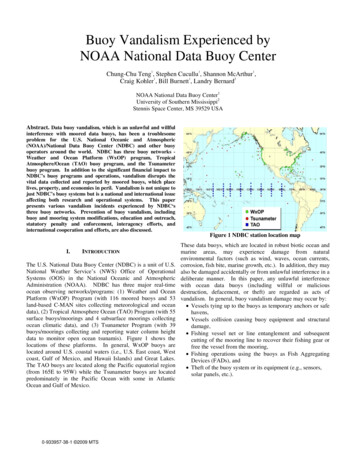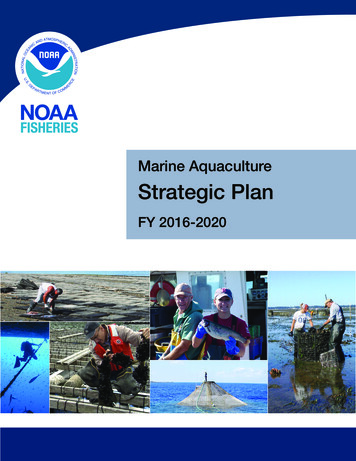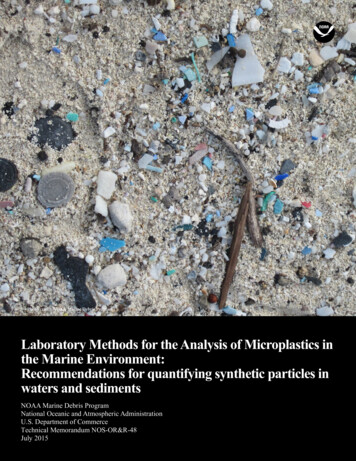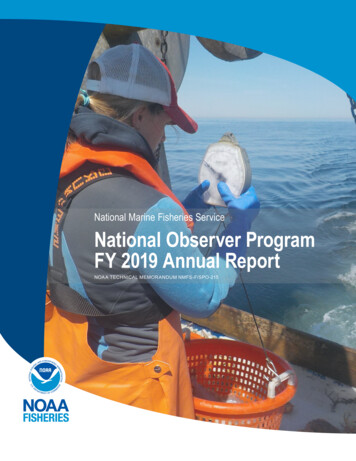
Transcription
National Marine Fisheries ServiceNational Observer ProgramFY 2019 Annual ReportNOAA TECHNICAL MEMORANDUM NMFS-F/SPO-215
National Observer ProgramFY 2019 Annual ReportLee Benaka (editor)National Marine Fisheries ServiceNOAA Technical Memorandum NMFS-F/SPO-215July 2021U.S. Department of CommerceGina Raimondo, SecretaryNational Oceanic and Atmospheric AdministrationRichard Spinrad, NOAA AdministratorNational Marine Fisheries ServiceJanet Coit, Assistant Administrator for Fisheries
National Observer Program FY 2019 ANNUAL REPORTRecommended citation:Benaka, L. (editor). 2021. National Observer Program FY 2019 Annual Report. NOAA Tech. Memo.NMFS-F/SPO-215, 30 p.Copies of this report may be obtained from:National Observer ProgramOffice of Science & TechnologyNational Marine Fisheries ServiceNational Oceanic and Atmospheric Administration1315 East-West HighwaySilver Spring, MD 20910Or online at:http://spo.nmfs.noaa.gov/tech-memosiiU.S. Department of Commerce National Oceanic and Atmospheric Administration National Marine Fisheries Service
National Observer Program FY 2019 ANNUAL REPORTTable of ContentsList of AcronymsvExecutive Summaryvi1. Introduction12. Budget Summary53. National Observer Program Activities4. Alaska Program Activities5. West Coast Program Activities610116. Pacific Islands Program Activities137. Greater Atlantic Program Activities148. Southeast Program Activities169. References20Appendix A: NOAA Fisheries Observer Programs Funded in FY 2019 by Region21Appendix B: Fisheries Observed in FY 201929U.S. Department of Commerce National Oceanic and Atmospheric Administration National Marine Fisheries Serviceiii
National Observer Program FY 2019 ANNUAL REPORTNOAA Fisheries continually works to develop and institute world-class training and safetyprotocols for observers. Above, observers practice staying afloat in immersion suitsduring a training session.ivU.S. Department of Commerce National Oceanic and Atmospheric Administration National Marine Fisheries Service
National Observer Program FY 2019 ANNUAL REPORTList of AcronymsA80Amendment 80M&SIMortality and Serious InjuryACLAnnual Catch LimitMVPMinimum Viable ProductACTAAtlantic Tunas Convention ActNBRNational Bycatch ReportADAnnual DeterminationNEFOPNortheast Fisheries Observer ProgramADPAnnual Deployment PlanNEFSCNortheast Fisheries Science CenterAFAAmerican Fisheries ActNFWFNational Fish and Wildlife FoundationAFSAmerican Fisheries SocietyNMFSNational Marine Fisheries ServiceASMAt-Sea MonitoringNOAANational Oceanic and Atmospheric AdministrationBRDBycatch Reduction DevicesNOPNational Observer ProgramBSAIBering Sea and Aleutian IslandsNOPATNational Observer Program Advisory TeamCDQCommunity Development QuotaNPFMCNorth Pacific Fishery Management CouncilCFRCode of Federal RegulationsNSPNational Seabird ProgramDSBGDeep-Set Buoy GearNWFSCNorthwest Fisheries Science CenterDWHDeepwater HorizonOAOpen AccessEBSEastern Bering SeaOLEOffice of Law EnforcementEEZExclusive Economic ZoneOPROffice of Protected ResourcesEFPExempted Fishing PermitPIFSCPacific Islands Fisheries Science CenterEMElectronic MonitoringPIROPacific Islands Regional OfficeEPIRBEmergency Position Indicating Radio BeaconPIROPPacific Islands Regional Observer ProgramESAEndangered Species ActPPAProgram, Project, and ActivityETElectronic TechnologiesPSMFCPacific States Marine Fisheries CommissionEVICEPIRB Visual Inspection CardPTNSPre-Trip Notification SystemFECAFederal Employees' Compensation ActRPGroundfish Trawl Rockfish ProgramFMAFisheries Monitoring and Analysis DivisionSASoutheastern AtlanticFMPFishery Management PlanSACSafety Advisory CommitteeFSBFisheries Sampling BranchSBLOPShark Bottom Longline Observer ProgramGARFOGreater Atlantic Regional Fisheries OfficeSBRMStandardized Bycatch Reduction MethodologyGOAGulf of AlaskaSEFSCSoutheast Fisheries Science CenterGOMGulf of MexicoSEZSouthern Economic ZoneHMSAtlantic Highly Migratory Species DivisionSTOffice of Science and TechnologyIFQIndividual Fishing QuotaSWFSCSouthwest Fisheries Science CenterLELimited EntryTACTotal Allowable CatchLOFList of FisheriesTEDTurtle Excluder DeviceMMPAMarine Mammal Protection ActTRTTake Reduction TeamMSA,MSFCMAMagnuson-Stevens Fishery Conservation andManagement ActWCGOPWest Coast Groundfish Observer ProgramU.S. Department of Commerce National Oceanic and Atmospheric Administration National Marine Fisheries Servicev
National Observer ProgramExecutive SummaryFor FY 2019 (October 1, 2018-September 30, 2019), 850observers provided 71,607 days of fishery observations. NOAA Fisheries, along with commercial fishingfleets in the Alaska, West Coast, and Greater Atlanticregions, invested 80.1 million to provide this coveragein 54 U.S. fisheries. Of this amount, congressionallyappropriated funds provided 55.0 million, and thefishing industry provided 25.1 million.The National Observer Program (NOP), in NOAAFisheries’ Office of Science and Technology, supported14 regional observer programs in FY 2019. The NOP,along with the National Observer Program AdvisoryTeam (NOPAT), supported a successful internationalfisheries observer and monitoring conference andprovided input on observer provider insurance issues,program performance metrics, budget developments,and other important topics pertinent to enactingmonitoring programs nationwide.The NOP and NOPAT continued to focus on safetyissues to a great extent in 2019 through the work ofthe NOPAT’s Safety Advisory Committee and throughthe initial implementation of recommendations fromthe Observer Program Safety Review. The NOP alsoprovided leadership on national bycatch estimationefforts, electronic monitoring (EM) coordination, andseabird conservation efforts.In addition to deploying observers to cover major U.S.fisheries across the United States in 2019, the regionalobserver programs achieved the following milestones: Alaska—Developed a draft annual deploymentplan for 2020, fulfilled observer program information collection requirements authorized underthe Paperwork Reduction Act, helped to analyzean exempted fishing permit for EM systems in theEastern Bering Sea and Gulf of Alaska trawl catchervessel fisheries, and supported the development of adraft environmental assessment/regulatory impactreview to increase the observer fee percentage tofund the deployment of observers and EM in thepartial-coverage program. West Coast—Provided data to support a proposedrule that would require certain commercial groundfish bottom longline vessels to deploy streamer linesor to set gear between civil dusk and civil dawnwhen fishing in federal waters north of 36 Northvi FY 2019 ANNUAL REPORTlatitude, contributed to a final rule to implementan EM program for two sectors of the limited entrytrawl fishery, and provided comprehensive observercoverage for deep-set buoy gear (DSBG) vesselsfishing under exempted fishing permits. Pacific Islands—Monitored takes of sea turtlesand false killer whales to support managementmeasures that can trigger closed areas or fisheryclosures, transitioned an Oracle-based observerdatabase housed at the NOAA Fisheries PacificIslands Fisheries Science Center to a Microsoftstructured query language database housed at theNOAA Fisheries Pacific Islands Regional Office, provided data for a report that quantified post-releasemortality rates of incidentally captured sharks, andcontinued to salvage dead, longline-caught seabirdsfor necropsy and dataset integration. Greater Atlantic—Provided 20 observer trainingsessions participating in approximately 12 differentoutreach events, supported efforts to implement EMtechnologies to augment data collection by observers, organzed a workshop to evaluate the processof completing the required observer pre-trip vesselsafety checklist, and hired several informationtechnology professionals. Southeast—Supported a program realignment planthat would consolidate observer programs locatedin three separate laboratories into one program,allowing more specialized employees to performessential program tasks; tested EM systems onshrimp trawl vessels to determine whether thesystems can collect sufficient images to account forsmalltooth sawfish and other large bycatch species;provided data to support a three-year review of theindividual bluefin tuna quota program; and continued to provide support for developing an observerprogram for the Gulf of Mexico menhaden purseseine fishery.The preceding milestones represent only a fractionof observer activities in 2019, which are detailedelsewhere in this report. None of these achievementswould be possible without the hard-working andtalented fishery observers who work under challengingconditions to help NOAA Fisheries fulfill its mission toensure sustainable fisheries.U.S. Department of Commerce National Oceanic and Atmospheric Administration National Marine Fisheries Service
National Observer Program FY 2019 ANNUAL REPORT1. IntroductionThe National Oceanic and AtmosphericAdministration’s National Marine Fisheries Service(NOAA Fisheries) deploys fishery observers to collecthigh-quality catch and bycatch data from U.S. commercial fishing and processing vessels, as well as fromsome shoreside processing plants. NOAA Fisheries hasbeen using observers to collect fisheries data in theU.S. exclusive economic zone (EEZ) and high seas since1972. Observers have monitored fishing activities onall U.S. coasts, collecting data for a range of conservation and management issues.Fisheries observers are trained biological technicianswho collect data to support a wide range of conservation and management activities. During FY 2019,NOAA Fisheries administered observer programs inall management regions (Alaska, West Coast, PacificIslands, Greater Atlantic, and Southeast).NOAA Fisheries regional offices and science centersadminister the various programs (Figure 1). Eachobserver program is authorized by one or more of thefollowing federal authorities: the Magnuson-StevensFishery Conservation and Management Act (MSA),the Marine Mammal Protection Act (MMPA), and theEndangered Species Act (ESA). (For more informationon these authorities, and U.S. observer program historyin general, see Brooke 2014.) The National ObserverProgram (NOP) supports observer programs andincreases their effectiveness in meeting the overallU.S. Observer ProgramsAlaskaAlaska Marine Mammal Juneau, AK(operates in years of funding)North Pacific Seattle, WAWest Coast NorthwestWest Coast Groundfish Seattle, WAAt-Sea Hake Seattle, WAGreater AtlanticNortheast Fisheries Woods Hole, MAAt-Sea Monitoring Woods Hole, MAIndustry Funded Scallop Woods Hole, MANationalObserver Program Silver Spring, MDWest Coast SouthwestDeep-Set Pelagic Longline Long Beach, CADeep-Set Buoy Gear Long Beach, CACalifornia Large-Mesh Drift Gillnet Long Beach, CAPacific IslandsHawaii-Based Pelagic Longline Honolulu, HIAmerican Samoa Pelagic Longline Pago Pago, ASAmerican SamoaSoutheastSoutheast Shrimp Trawl Galveston, TXGulf of Mexico Reef Fish Galveston, TXSoutheast Coastal Gillnet Panama City, FLShark Bottom Longline Panama City, FLAtlantic Pelagic Longline Miami, FLFigure 1: Locations of regional and national observer programs.U.S. Department of Commerce National Oceanic and Atmospheric Administration National Marine Fisheries Service1
SponsorsDirector of Office ofChief ScienceScience&TechnologyAdvisorNational Observer Program FY2019 ANNUAL REPORTNOP Advisory Team (NOPAT)gerSets policy and budgetary direction for the NOP. Members include representatives from NOAA FisheriesHQ offices, Regions, and Science Centers, as well as a U.S. Coast Guard liaison.eenOffice of Science Office of Sustainable Office of ProtectedOffice of LawOffice ternationalAffairsFisheries HQRegionalGreater AtlanticPacific IslandsSoutheastAlaskaWest CoastOfficesScienceAlaskaNortheastNorthwestPacific IslandsSoutheastSouthwestCentersGeneral CounselGeneral Counsel forU.S. Coast Guardfor FisheriesEnforcement and Litigation(liaison)esand.ryandesentams,el andent,rd.nty alsoDeputy Assistant Administratorfor Regulatory ProgramsRegional ProgramsFigure 2: Organizational structure of the NOP Advisory Team.goals of NOAA Fisheries through improvements indata collection, observer training, and integration ofEachregionalObserverobserverdatawith otherresearch.Program is responsiblefor monitoringdifferent1.1 ProgramStructurespecies and gear types.Within the NOAA Fisheries Office of Science andClick on the shadedTechnology (ST), the NOP nationally coordinates uparea of the map toto 17 observer programs in five regions. In addition tolearn more about eachnational program administration, budget development,region’s work.and planning, the NOP works with regional observerprograms to develop national policy, standards forobserver data quality, and training standards forobserver and marine safety instructors.As of FY 2019, the NOP had three permanent staffpositions: program coordinator (Elizabeth Chilton),bycatch expert (Lee Benaka), and safety expert(Dennis Hansford). The NOP hosted Andrea Chan, aKnauss Marine Policy Fellow, for a one-year term to,among other things, support the National ObserverProgram Advisory Team (NOPAT) and analyze datarelated to the U.S. National Bycatch Report’s (NBR) TierClassification System. (For more information on theTier Classification System, see Desfosse et al. 2012.)In addition, Electronic Technologies Coordinator BrettAlger hosted Knauss Marine Policy Fellow KatherineWilson, as well as two NOAA Fisheries employees ondetail to ST: William Duffy from the Greater AtlanticRegional Office and Joshua Lee from the Pacific IslandsRegional Office.The NOP also provides regional observer programs with a forum to increase collaboration and2communication during biannual NOPAT meetings.Representatives from all regional fisheries sciencecenters and regional offices, as well as many NOAAFisheries Headquarters offices with observer expertise,participate on the NOPAT (Figure 2).Regional observer programs are responsible for theirday-to-day operations, including providing administrative services, responding to data requests from a rangeof users, and working closely with third-party contracting companies that provide observers and addresslogistics and operational issues. Program scientistsdetermine the appropriate sampling protocols andnecessary observer coverage levels for each fishery. Ingeneral, regional programs work with observer provider companies to recruit, train, and deploy observers.The FY 2019 budget included funds to pay for mostregional observer program costs for the fisheriescurrently observed. NOAA Fisheries has authority torequire that industry fund observer coverage. Thus, insome cases, the fishing industry pays for the costs ofobserver coverage by contracting directly with privateobserver provider companies to obtain the requiredcoverage. The full (100 percent) coverage fisheriesmanaged by the Alaska Observer Program, for example,are funded primarily by the fishing industry, whichpays observer salaries, travel costs, and insurance.Onshore infrastructure costs are covered by NOAAFisheries. The partial coverage fleet in Alaska is paidby an ex-vessel fee determined by the North PacificFishery Management Council and implemented infederal regulations. NOAA Fisheries’ Alaska FisheriesU.S. Department of Commerce National Oceanic and Atmospheric Administration National Marine Fisheries Service
National Observer Program FY 2019 ANNUAL REPORTScience Center administers this program, contractswith an observer provider company, and receives thedata for near real-time management of the groundfishfishery. These data are also made available to industrymembers. Industry funding also supports the WestCoast Trawl Catch Share Program and the Atlantic SeaScallop Fishery.Regardless of an observer program’s funding structure,NOAA Fisheries provides all observers with trainingin sampling techniques and species identification,data collection, fishing and safety regulations, andat-sea survival skills. NOAA Fisheries is responsiblefor ensuring data quality through what is known asdebriefing. This quality-control process involves dataand sampling process review, as well as discussionsNOAA Fisheries manages multiplewith the observers themselves, before observer dataare used to help fulfill agency science and managementobjectives.1.2 Use of Observer Data in FisheriesManagementThe information compiled by observer programssupports the management of fisheries and conservation of fish stocks, protected species, and ecosystemsthroughout the United States (Figure 3). Observer dataare also increasingly relied on to monitor compliancewith fisheries regulations. Information collected byfisheries observers is used for a wide range of assessment and monitoring purposes, including the followingexamples:observer programs covering federaland state waters from Maine to Hawaii.Our programs process and managedata and biologicalsamples collectedby observersduringcommercialfishingTo inform stockassessments& fisherymanagementtrips.To collectbiological samplesfor specialcollections &researchTo informbycatch reductioneffortsHow do weuse observerdata?To documentcommerciallyimportant, special,& endangeredspeciesTo recommendsustainableseafood choices(FishWatch)To provideinformation for thescientific & researchcommunityTo explore newfisheries & revisitsmall fisheriesFigure 3: Uses of observer data.U.S. Department of Commerce National Oceanic and Atmospheric Administration National Marine Fisheries Service3
National Observer Program For each managed fishery or stock, the MSA requiresdevelopment of an annual catch limit (ACL) thatis set below the overfishing level to ensure thatoverfishing will not occur. Setting an ACL for astock requires scientific data on catch and bycatch,which has resulted in increased observer days at seaacross the country. Catch share programs rely on observer data tomonitor catch, landings, and discards. In many casesthese fisheries require enhanced observer coverageto document vessel-specific or sector-level quotas.Managers and fishermen rely on observer data toensure that vessels and sectors do not exceed theauthorized quota of target or discard species.Number of Fisheries, Days, or Observers For many fisheries, estimates of the rates of fishingmortality and/or protected species interactionbased on observer data are used for monitoring fishery performance and developing stock assessments.FY 2019 ANNUAL REPORTBiological samples collected by observers are alsoessential inputs to stock assessments (e.g., geneticdata are used for species or stock identificationpurposes). For stocks that are overfished and in a rebuildingplan, such as Atlantic cod, preseason target catchnumbers are provided to the management team.When the fishing season ends, observer data areevaluated to determine total mortality and correspondingly adjust the next season’s targets. The MMPA requires that levels of fishery-relatedmortality and serious injury of marine mammalsbe monitored by observers and reported in annualmarine mammal stock assessment reports. Thesedata are also used to appropriately classify commercial fisheries according to their levels of incidentalmortality and serious injury of marine mammals inthe annual MMPA List of Fisheries (16 U.S.C. § 1387). Observer data are used by industry in innovativebycatch avoidance programs, such as salmonbycatch monitoring in Alaska. Observer data support NOAA Fisheries’ series ofNational Bycatch Reports (e.g., Benaka et al. 2008 2010YearsSea Days Observed x 1000No. Observers x 10201220142016Funding Amount (Millions) In some fisheries, the amount of a specific fishspecies that can be caught is specified by a totalallowable catch (TAC) level. Observer data are usedto project total catches for these species and tomonitor the level of fishing activity so that the TACis not exceeded. 2018All Funding (Appropriated and Industry)Fisheries ObservedFigure 4: U.S. observer program sea days observed, appropriated and industry funding (not adjusted for inflation), and number ofobserved fisheries and observers from 1998 to 2019.4U.S. Department of Commerce National Oceanic and Atmospheric Administration National Marine Fisheries Service
National Observer Program FY 2019 ANNUAL REPORTwhich provide regular estimates of fish, marinemammal, sea turtle, and seabird bycatch for majorU.S. fisheries. Under ESA Section 7 biological opinions, observerprograms may be required or recommended toensure that anticipated take levels of threatened orendangered species (e.g., sea turtles and Atlanticsturgeon) are not exceeded in federal fisheries.1.3 Funding History for ObserverProgramsThe NOP was formed in 1999 to improve regional andnational coordination among the observer programs.Before 1999, the majority of funding for regional2. Budget SummaryFor FY 2019 (October 1, 2018-September 30, 2019), 850observers provided 71,607 days of fishery obsevervations. NOAA Fisheries, along with commercial fishingfleets in the Alaska, West Coast, and Greater Atlanticregions, invested 80.1 million to provide this coveragein 54 U.S. fisheries. Of this amount, congressionallyappropriated funds provided 55.0 million, and thefishing industry provided 25.1 million (Table 1.)The tables in Appendix A provide regional details onnumbers of observers, sea days covered, observercoverage targets, and expenditures for observercoverage. Appendix B lists the 54 fisheries covered inFY 2019. Industry funds were used to support observercoverage of fishing vessels in North Pacific and WestCoast groundfish fisheries as well as Greater Atlanticscallop fisheries.observer programs was provided through indirectsources such as congressional allocations supportingfisheries management and protected species conservation and recovery, or were funded by industry. Industryfunding has increased over time as mandatory coverage requirements have increased.In 1999, the first congressional funds were directlyappropriated to specific regional observer programbudgets or Program, Project, and Activity (PPA) lines,and the NOP was established to coordinate observerprogram activities. The number of observed fisherieshas gradually increased as available funding providedthe means to develop observer programs for new orexperimental fisheries while maintaining establishedmonitoring programs (Figure 4).As shown in Figure 1, observer programs are administered by NOAA Fisheries Regional Offices and ScienceCenters around the country. Funding received by eachprogram is used to operate existing programs, developobserver programs for new or experimental fisheries,and conduct outreach to industry members and thepublic. Observer coverage levels are determined bythe regional programs and are influenced by available funding, the number of active participants in thefishery, fishing conditions, fishery quotas, managementneeds, and program goals. Sections 4 through 8 of thisreport summarize the FY 2019 achievements of NOAAFisheries regional observer programs.RegionAppropriatedIndustryTotalAlaska 8.3 19.2 27.5Greater Atlantic 22.8 2.2 25.0Pacific Islands 8.5 0 8.5Southeast 6.3 0 6.3West Coast 8.4 3.7 12.1NOAA Fisheries Headquarters 0.7 0 0.7Totals 55.0 25.1 80.1Table 1: FY 2019 Observer Funding Summary (in millions). Appropriated amount shownincludes funds allocated to regions from FY 2019 enacted funding.U.S. Department of Commerce National Oceanic and Atmospheric Administration National Marine Fisheries Service5
National Observer Program FY 2019 ANNUAL REPORT3. National Observer Program ActivitiesSeveral NOAA Fisheries offices play important rolesin observer programs. These offices include the Officeof Science and Technology, which is home to the NOP,as well as the Office of Protected Resources (OPR),the Office of Law Enforcement (OLE), and the Officeof Sustainable Fisheries, which houses the AtlanticHighly Migratory Species Management Division (HMS).The following sections describe NOP, OPR, and OLEactivities in 2019. Section 8 of this report describesHMS-related activities for 2019.3.1 National Observer ProgramIn addition to coordinating policy and budget issuesamong the regional observer programs, the NOPfacilitated and coordinated several activities thatwere national in scope in 2019. These activities aredescribed below.3.1.1 National Observer Program AdvisoryTeamThe NOPAT met twice in 2019, in April/May andNovember. At these meetings, the NOPAT discussedvarious topics including the observer program budget,policies and standards, strategic planning, observerprovider insurance requirements, safety and enforcement issues, performance metrics, and electronictechnologies. In addition, NOPAT members planned asymposium for the 2019 American Fisheries Society(AFS) Annual Meeting entitled “Fishery-DependentObserving and Monitoring.”3.1.2 Safety Advisory CommitteeThe NOPAT has a Safety Advisory Committee (SAC)that comprises safety representatives from eachregional observer program, the NOAA Fisheries Officeof Law Enforcement, and the U.S. Coast Guard. The SACprovides recommendations to the NOPAT on safety andhealth issues. Committee members meet in person andover the phone regularly, with an in-person meetingin April 2019 and conference calls in July and August2019. Also in 2019, the SAC developed a series of safetyfact sheets covering topics such as practicing properlifting techniques, detecting and mitigating bed buginfestations, donning immersion suits, and monitoring1marine pollution violations. The SAC also planned amarine safety instructor traning session for September2019, as well as developed recommendations forrevised observer safety training and eligibility standards. Suggested updates to safety training standardsincluded expanded emphasis on harassment (including assault, intimidation, and coercion) and conflictresolution.3.1.3 2016 Observer Safety Program ReviewAt the end of FY 2016, NOAA Fisheries initiated anindependent audit of current observer-related policiesand protocols. The resulting Observer Program SafetyReview Report found national and regional observersafety programs in the United States to be robust,mature, and effective.1 The report provided 118 recommendations across seven relevant observer safetycategories: Safety reporting. Communications. Practices and policies. Training. Regulations. Equipment. International observers.In May 2019, the NOP released an action plan thatincluded updates on the implementation status of theserecommendations, including those completed in 2018.Since the last update, more than half of the recommendations have been implemented. The remainderare in process of implementation or pending furtherassessment to incorporate into regional and nationalobserver safety programs.Many of the responses to the report equate to theinitiation of practices that augment standard safetyprotocols or ongoing safety training activities. Theprocess of prioritizing the work to address pendingrecommendations, and integrate these new measureswith current safety practices, policies, and procedures,is continuing. Also continuing is the long-term goal ofdeveloping standards that address safety matters in allThe 2018 report is available at bserver-safety-program-review-report6U.S. Department of Commerce National Oceanic and Atmospheric Administration National Marine Fisheries Service
National Observer Program FY 2019 ANNUAL REPORTphases of an observer’s career. After considerablereview, ten of the report’s recommendations weretabled as these required substantive regulatory,legislative, or policy changes.NOAA Fisheries has completed Phase 1 of theAction Plan by assessing, categorizing, and prioritizing the numerous report recommendations, aswell as implementing many of the high-priorityrecommendations. NOAA Fisheries continues tofocus on Phase 2 and 3 of the Action Plan with theimplementation of more complex recommendations such as: Finalizing a national rule to establish minimuminsurance requirements for observer providers. Streamlining pre-trip vessel safety checklistsappropriate to vessel size and trip length. Updating medical clearance checklists. Expanding the Observer Safety Standardsframework to address safety elements throughout an observer’s career.The NOP publishes regular status updatesAn Alaska observer stands on the snow-covered deck of a vessel.regarding Observer Safety Program Review recommendations on its website.2To proceed with this effort, NOAA Fisheries asked3.1.4 Observer Program and Provider Insurance the public for technical information on the types ofinsurance and minimum coverage amounts (in dollars)Rulemakingthat would minimize observer deployment risks to theextent practicable considering costs and other factors.In 2019 the NOP analyzed public comments received inAdditionally, NOAA Fisheries asked for public commentresponse to a Federal Register request for informationon Federal Employees Compensation Act (FECA) claims(83 FR 32829) regarding a national initiative to reformand benefits processing for observer occupationaland streamline observer provider insurance requireinjuries and whether observer companies shouldments. The NOP undertook this reform effort to:carry private insurance to supplement FECA benefits Ease the regulatory burden and reduce costs forfor observers. Based on public input, NOAA Fisheriesprivate companies that provide observer staffing todrafted a proposed rule to establish minimum insurNMFS observer programs through more efficient,ance requirements for observer providers.nationally applicable insurance requirements. Eliminate outdated and/or inappropriate regulatoryrequirements. Reduce observer deployment risks for vessel ownersand shore side processors. Identif
who collect data to support a wide range of conserva-tion and management activities. During FY 2019, NOAA Fisheries administered observer programs in all management regions (Alaska, West Coast, Pacific Islands, Greater Atlantic, and Southeast). NOAA Fisheries regional offices and science centers . administer the various programs (Figure 1). Each
